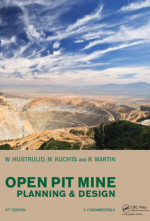Добрый день, Коллеги. Важное сообщение, просьба принять участие. Музей Ферсмана ищет помощь для реставрационных работ в помещении. Подробности по ссылке
Open pit mine planning and design / Планирование и проектирование открытых горных работ
One of the first things discussed in an Introduction to Mining course and one which students must commit to memory is the definition of ‘ore’. One of the more common definitions (USBM, 1967) is given below:
Ore: A metalliferous mineral, or an aggregate of metalliferous minerals, more or less mixed with gangue which from the standpoint of the miner can be mined at a profit or, from the standpoint of a metallurgist can be treated at a profit.This standard definition is consistent with the custom of dividing mineral deposits into two groups: metallic (ore) and non-metallic. Over the years, the usage of the word ‘ore’ has been expanded by many to include non-metallics as well. The definition of ore suggested by Banfield (1972) would appear to be more in keeping with the general present day usage.
Ore: A natural aggregate of one or more solid minerals which can be mined, or from which one or more mineral products can be extracted, at a profit.
In this book the following, somewhat simplified, definition will be used:
Ore: A natural aggregation of one or more solid minerals that can be mined, processed and sold at a profit.
Although definitions are important to know, it is even more important to know what they mean. To prevent the reader from simply transferring this definition directly to memory without being first processed by the brain, the ‘meaning’ of ore will be expanded upon. <...>




